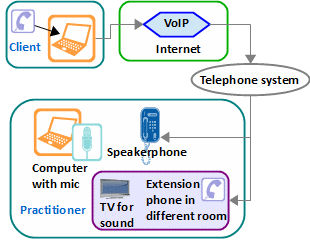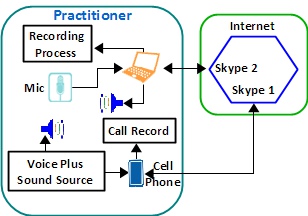Originally published in the Fall 2012 ATransC NewsJournal
Also see: Phone Line EVP and Recording EVP Using a Telephone
Recording for EVP using the telephone system has always offered tantalizing possibilities. In recent years, cell phones and answering machines have produced good but usually spontaneous EVP. Now, we see more people using the Internet for planned EVP sessions.
Voice over Internet Protocol (VoIP) is the technology that makes it possible for a person to use a computer to call another computer via the Internet or even call a landline telephone via the Internet. The most commonly used service has been Skype.com, but others are coming along, including Google Voice (google.com/voice).
This article describes some of the more successful techniques being reported to us by members and associates.
Sonia Rinaldi

Brazilian researcher, Sonia Rinaldi, is a veteran transcommunication researcher. With members of the organization she coordinates, IPATI (translation from Portuguese: Institute for Advanced Research in Instrumental Transcommunication), she has been diligently seeking ways to improve both visual and audible communication across the veil. We have included a number of articles on her work over the years which may be accessed in the Idea Exchange archive.
The Idea Exchange has been converted to “Read Only” due to lack of participation.
Please contact us if you have questions.
IPATI has been a leader in developing new techniques for EVP using the telephone system and Skype. A major part of Sonia’s work involves reunions and she has produced some very convincing results using these techniques. We asked Sonia to elaborate on her current setup. Here is her answer with the help of Sonia’s translator, Cristina:
Description of Technique
This is the configuration of equipment used by Sonia Rinaldi for her recent work with reunions.
In the laboratory: a speakerphone is placed beside a laptop configured to record via a microphone.
The client, who is anywhere in the world, calls that phone via a computer using Skype (voice only). The telephone is answered by the practitioner (Sonia in her reports) who initiates the recording session in the computer, sets the telephone to speakerphone mode and leaves the room.
The practitioner then goes to a second room in the same building and picks up an extension phone located near a television. As a sound source, the television is tuned to an English or German-language news channel (any language other than the practitioner’s native language).
Via the telephone, the client speaks to his or her loved one on the other side while the practitioner listens to make sure that the client asks questions while leaving a thirty-second pause for the etheric communicator’s response.
In this technique, the voice from the television, as the background sound, appears to be transformed to produce answers from the loved one. While the background sound is in one language, the resulting utterance is in Portuguese.
Preparation
The client is instructed to prepare questions before calling Sonia’s lab in Brazil via Skype. From client Christina, “Before calling Sonia’s lab in Brazil, I prepared questions to maximize the communication with my son Stefano. I also decided at the last minute to call from my bedroom, the quietest place in the house.”
After the call is connected: “All of a sudden Stefano validates his presence by saying that I was in my room, something I had not mentioned because it was a last-minute decision. I could clearly hear my parents and husband as well, which gives me the hope that I will rejoin my loved ones sometime in the future.
“Another communication that amazed me was his suggestion that I contact a friend and girlfriend of his: Lina.
“I contacted Lina the next day and she told me that it was an amazing ‘coincidence’ that I called. She had been thinking of Stefano and had decided to call me the same day to take me out for lunch. We had lunch together and she surprised me with a gift: a heart-shaped silver locket and chain bearing the words on both side: ‘Stefano, ever loved, never forgotten.’”
Debbie Caruso

As reported in the Spring 2007 ATransC NewsJournal, “Recording EVP Using a Telephone,” before her transition, Debbie Caruso had been using a landline telephone and computer for recording EVP. The elements of her setup are shown in the following diagram. A recording program such as Audacity or Audition was used in the computer. (Use Phone and Modem in the Control Panel to control the modem in Windows 7.) A telephone was connected to a second telephone wall jack, but she sometimes used a headset that connects to the computer.
An example of what Debbie was recording is in the article, “Jenny and Brandon – The Newlyweds”
Margaret Downey

Margaret Downey uses an Apple computer and iPhone to conduct VoIP sessions. With two Skype accounts, she calls one with the phone and the other with her computer. Both are in the same room but about eight feet apart. A sound source plays into the room near the cell phone.
During the call, Margaret’s voice from the cell phone plays out of the computer speakers. A feedback loop is formed because the phone picks up Margaret’s voice, the background sounds and the output of the speaker. So, if the phone is too close to the computer speakers, there will be a loud “feedback” noise. Part of the task is to find the best location for everything so that there is a little feedback, but not enough to cause the loud noise.
When the call is answered with her computer, Margaret starts an app named Call Record (ecamm.com). (A similar Windows app is PrettyMay Call Recorder: prettymay.net.)
An interesting observation about Margaret’s setup is that the call recorder displays both sides of the conversation so that the caller’s voice is strong on the receive side but also slightly delayed. The send side also has the caller’s voice but much weaker.
![]()

Pretty intriguing! I wonder what makes these setups so usable for ITC. Are the many transistion points and conversions in this big telephone loop the crucial point? Is it the complexity of it that makes it prone to the influence of ghosts?
We just do not know. In the circuits used in the examples discussed here, I am pretty sure the circuits use a transformer that converts 4-wire for the carrier side to 2-wire for the telephone set side. They are balanced so that the feedback on the 2-wire side is near beginning to howl. That instability gives us the “live circuit” sense.
The feedback increases the uncertainty of the circuit. I suspect it is the increased uncertainty that enables EVP. Take a look at https://atransc.org/itc-via-telephone/. You can hear a sound as if the EVP signal is breaking into the noise of the answer machine circuit. That also gives us a possible hint about how the signals are combined.
Hey there,
I’m soon to cross over and looking for the clearest way to set up Class A communication systems. Can someone help me with configuring? I’m not in the USA, but believe this method is the best available and want to explore my options.
Thanks,
I’m trying to use Margaret Downey’s set up. I Have questions about the details. Was it a constant feedback loop or only while talking? How loud was the output from the computer?
If there is a way I could contact Magaret Downey directly that would be great.
Thanks in advance
Hi Phyllis. It’s been a number of years since I worked with this method so I’ve gotten fuzzy on some of the details over time, but i do recall having to make volume adjustments based on real-time assessment of the feedback loop quality. I’ll send you an email from my private address. Margaret